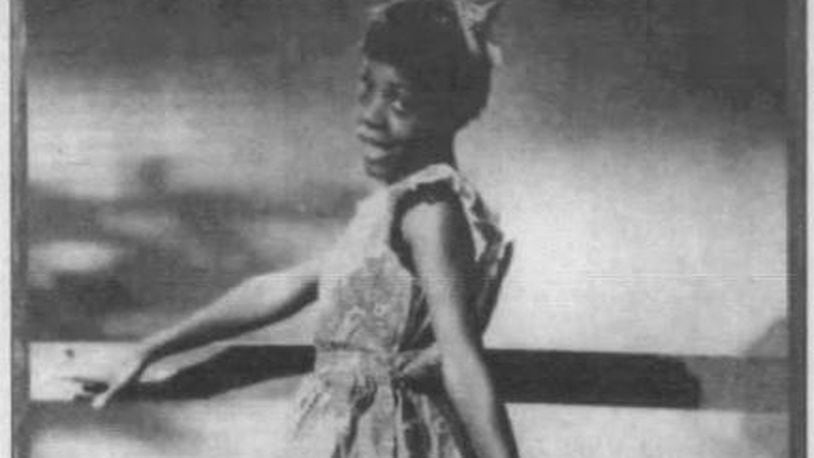- Funk Box Experience: Interactive tool teaches how Dayton funk helped form modern music
Here’s a look at some notable pre-funk artists from the Dayton area.
The Mills Brothers
John Mills Jr. (guitar, bass and vocals) and siblings Herbert (tenor vocalist), Harry (baritone vocalist) and Donald (lead tenor vocalist) were born in Piqua and went to school in Bellefontaine. The jazz and pop vocal quartet went on to major stardom in the 1930s, making more than 2,000 recordings, selling more than 50-million units, scoring more than three dozen gold records and appearing in several major motion pictures.
The Mills Brothers were known for close harmonies and for spicing up their performances by making horn sounds with their mouths. It was so effective the group’s early recordings included the notice the only instrumental accompaniment was one guitar.
When they signed a three-year contract with CBS for their own radio show, the Mills Brothers became the first African American group to have their own network radio show. “Tiger Rag,” the Mills Brothers first recording for Brunswick Records, hit number one on the charts. Numerous other hits followed, including “Goodbye Blues,” “Nobody’s Sweetheart,” “Lazy Bones” and “Shoe Shine Boy.”
The singers made their film debut alongside Cab Calloway and Bing Crosby in Paramount’s “The Big Broadcast” (1932). Other film appearances followed.
Little Miss Cornshucks
Mildred Cummings, who performed as Little Miss Cornshucks, was born in Dayton on May 26, 1923. Relatively unknown today, she was a star in her prime, known for her trademark gingham dress, bloomers, pigtailed wig and straw hat. She was a lifelong favorite of Atlantic Records founder Ahmet Ertegun and an acknowledged influence on Aretha Franklin, Ruth Brown, Johnny Ray, LaVern Baker and other singers.
Little Miss Cornshucks was a hit in urban Black theaters like the Apollo in New York, the Howard in Washington, D.C. and the Regal in Chicago. She was equally popular with interracial crowds at clubs like the DeLisa in Chicago and the Baby Grand in New York, and with all-white audiences at the Million Dollar Theater in Los Angeles.
In 1960, Cummings recorded “The Loneliest Gal in Town,” her lone full-length album. The Chess Records release featured new versions of some of her most popular songs and new material. It didn’t spark a career resurgence and Cummings retired from performing in 1966. She was living in Indianapolis when she passed away at the age 76 in 1999.
Dean and Jean
When Welton Young and Brenda Lee Jones began performing together in the late 1950s, they took a cue from popular contemporary acts such as Shirley and Lee and Johnnie and Joe and dubbed themselves Dean and Jean. The duo released some great singles between 1958 and 1966, two of which were national Top 40 hits.
Dean and Jean’s biggest run of hits began in late 1963 with the release of “Tra La La La Suzy,” which peaked at number 35 on the Billboard Hot 100 in January 1964.
Two more singles made the Billboard Hot 100 that year. “Hey Jean, Hey Dean” was the duo’s highest charting song, reaching 32 on April 4. The follow-up, “I Wanna Be Loved,” peaked at 91 on June 20. Despite strong material, the handful of releases that followed failed to chart. This drop in sales had less about the quality of songs and more to do with the rise of Beatlemania in the United States.
Piney Brown
This blues singer was born Columbus S. Perry in Birmingham, Ala. on January 20, 1922, but was an honorary Daytonian. Brown began performing professionally in the early 1940s and was already highly regarded in music circles when he relocated to the Gem City in 1964.
Brown made his first recordings for Miracle Records in 1947. This marked the beginning of the singer’s most prolific period as he moved from label to label over the next 10 years, cutting tracks for Apollo, Duke, King, Sound Stage 7 and other companies. He also worked as a songwriter for King Records and penned songs for James Brown and Little Milton. Although Brown never scored any major hits, his old 45 and 78 RPM records are sought after today by collectors of blues and R&B.
While his vinyl output slowed after moving to Dayton, Brown continued to record and perform. He became involved in the local music scene, performing in area clubs and working with future members of the Ohio Players, Slave and other well-known acts. He was 87 when he passed away in Dayton in February 2009.
Roy Meriwether
This Dayton-born son of a minister began figuring out songs by ear when he was only 3. The jazz pianist was 17 when he first started performing around Dayton in Third Street clubs like the Blue Note and The Nowhere. Meriwether was 22 when he signed his record deal with Columbia Records, which released his debut album, “Soup & Onions,” in 1966. “Popcorn & Soul,” his second of four Columbia albums, featured instrumental jazz versions of film music with songs such as “Zip A Dee Do Dah’ and the Beatles” and “Help!”
When Meriwether played his first gigs at the Blue Note he was in a trio backed by Isaac Sloan (bass) and Joseph Arnold (drums), who appear on his Columbia debut. Outside a few exceptions, he stuck with the trio format for his entire career.
He moved to New York City in 1976, where he spent the rest of his life, but Meriwether came back home frequently for performances at Gilly’s, Crown Plaza, Memorial Hall and other spots. He passed away in December 2021.
BLACK HISTORY MONTH
Throughout February, the Dayton Daily News is highlighting the impact of Black trailblazers and leaders on our area, showcasing Black Daytonians’ contributions to the arts, and elevating Black perspectives on solutions to shared challenges. Read all of this coverage at daytondailynews.com/black-history.
